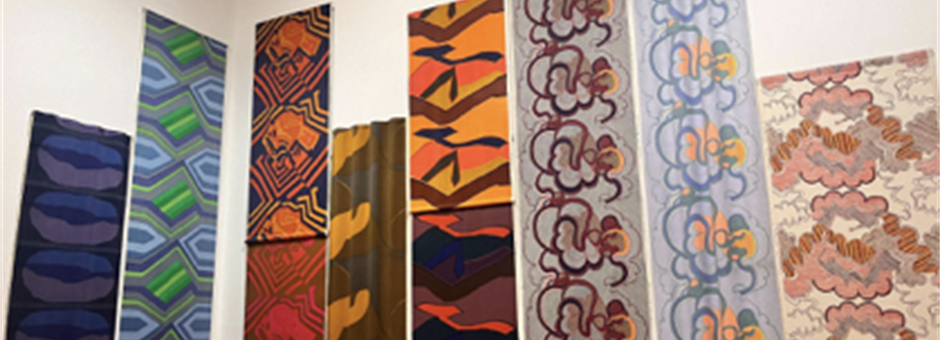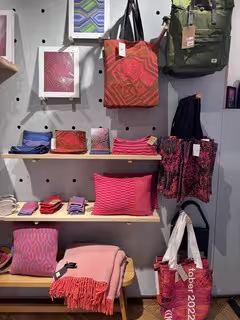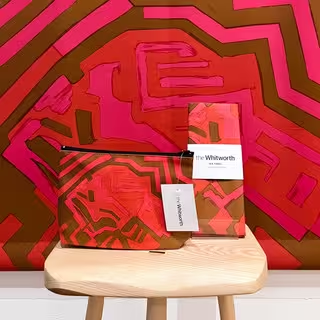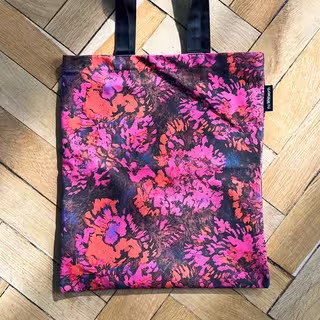
Behind the Scenes
Behind the Scenes
Shirley Craven Exhibition and Merchandising at the Whitworth Gallery
Behind the Scenes
Behind the Scenes
Shirley Craven Exhibition and Merchandising at the Whitworth Gallery
Behind the Scenes: Shirley Craven Exhibition and Merchandising at the Whitworth Gallery
Shirley Craven’s exhibition at the Whitworth offers a compelling examination of her pioneering work in textile design within the context of the broader trajectory of post-war British art and design. Born in Hull in 1934, Craven’s formative experiences of evacuation during the Second World War and her education at Hull College of Art and the Royal College of Art (1955-58) were instrumental in shaping her distinctive approach to textiles. At the heart of her ethos is the belief that ‘textiles should be an artistic field, not just a commercial transaction. The designer should have the same impetus as the painter, should design hoping to sell rather than with the sole purpose of selling.’ Following her philosophy, she created innovative designs that would transcend the conventional ideas of textile art.
In 1959, at just 25 years old, Craven was appointed Art Director and Chief Designer at Hull Traders. She played a pivotal role in discovering and nurturing young artistic talent, helping cultivate the bold and abstract prints synonymous with the Hull Traders’ commercial prominence in the 1960s and 1970s.
The Whitworth Gallery’s exhibition gives us an opportunity to revisit these seminal designs 60 years after some were first displayed at the Whitworth in the exhibition Brown/Craven/Dodd: 3 textiles designers (1965), as a part of a series celebrating award-winning young designers of the 1960s. The Whitworth Gallery is home to over 80 of Craven’s textiles, forming part of a broader series at the Whitworth that celebrates the contributions of women artist-designers in its collection. The exhibition transforms the gallery space with a beautiful array of textiles that reflect Craven’s mastery of abstraction and colour. Throughout, Craven’s craftsmanship is evident. Her design process involved creating drawings at the same scale as the finished prints, eliminating the need for enlargement and preserving the original design. This meticulous approach is exemplified in series such as ‘Sixty-Three’ (fig. 3) and ‘Shape’ (fig. 1, fourth from left), which encapsulate the large-scale characteristics of her designs.
I had the opportunity to get in touch with Senior Curator (Collections & Textiles and Wallpapers) Amy George, who spoke a little about the exhibition. When asked if the way the exhibition is presented had preserved the intended display of the textiles, she explained that the pieces are displayed on horizontal wavy battens allowing them to drape naturally, so that the textiles evoke their original purpose as furnishing fabrics, particularly curtains, while simultaneously asserting their status as art objects (fig. 1). In terms of the process of draping the fabrics along the walls, they are not stitched to curtain tape and the selvedges at the edge of the fabric are showing, which would not be typical in a domestic setting. This is because they hold information about the textiles, and ultimately, they are being displayed as objects in a gallery setting and not as decoration. This approach underscores the dual identity of the textiles as both functional objects and works of art.

Fig. 1: Shirley Craven Exhibition, Whitworth Gallery. Photo: Karin Howell
This was a collection display being worked on with a small budget, so there were likely fewer displayed textiles than George would have preferred, but overall she was happy with the hanging method. Craven herself was not able to travel to Manchester to view the exhibition, but she did speak with George on the phone before the show and expressed content with the display methods.
A significant aspect of the exhibition’s impact lies in its merchandising, which bridges a gap between art and accessibility, and reflects on Craven’s observations on textiles as art and commerce (fig. 2). I was also lucky enough to get the opportunity to speak to Buyer and Product Developer Emma Gittins and Whitworth Enterprise Administrator Ruth Wedgbury, who both kindly answered my questions about the process of transforming Craven’s textiles into merchandise. The process required a collaborative effort involving the curatorial team, Craven’s family and a network of suppliers. The process began with an implementation meeting where the exhibition concept was presented alongside selected works. Securing commercial usage rights involved discussions with Craven’s grandson, who granted full permission to reproduce her designs.

Fig. 2: Shirley Craven Merchandise Table, Whitworth Gallery, Photo: Ruth Wedgbury

Fig. 3: Shirley Craven Merchandise of ‘Sixty Three’ (1963) Photo: Ruth Wedgbury
High-resolution images of the textiles were sent to suppliers along with detailed briefs, and sample products were created. Items such as scarves required particular attention to detail, with cropping decisions undergoing multiple rounds of feedback from the curatorial team and Craven herself. Sustainable materials such as cotton were prioritised to align with contemporary values, and pricing was kept affordable to ensure accessibility. Craven’s selflessness shone through in her decision to forgo personal profit.
In terms of how the team decided which artworks were suitable for which object, factors such as the prominence of the artwork in the exhibition, its adaptability to different products, and audience preferences were all taken into account. Customer feedback and market trends also played a role. The merchandise not only complements the exhibition but also extends its reach, allowing visitors to take home a piece of Craven’s artistry. Efforts were made to maintain colour consistency and fidelity to the original designs, thus ensuring that the merchandise resonates with audiences while providing a new way for them to engage with the textiles (figs 3 and 4). Social media and online promotion have further amplified the exhibition’s and the merchandise’s popularity.

Fig. 4: Shirley Craven Merchandise, Bag of ‘Le Bosquet’ (1959) Photo: Ruth Wedgbury
As the exhibition runs until March 16, 2025, it offers a rare opportunity to immerse yourself in the world of Shirley Craven. I hope this glimpse into what goes on behind the scenes has inspired you to go and experience the exhibition and merchandising with fresh eyes. After learning a little more about the creative vision, curatorial decisions, and collaborative efforts involved, you will see the artistry that lies within the textiles and the way they are brought to life for audiences today.
Karin Howell
Friends of the Whitworth Student Ambassador
BA History of Art Third-Year Undergraduate, University of Manchester
January 2025
Behind the Scenes: Shirley Craven Exhibition and Merchandising at the Whitworth Gallery
Shirley Craven’s exhibition at the Whitworth offers a compelling examination of her pioneering work in textile design within the context of the broader trajectory of post-war British art and design. Born in Hull in 1934, Craven’s formative experiences of evacuation during the Second World War and her education at Hull College of Art and the Royal College of Art (1955-58) were instrumental in shaping her distinctive approach to textiles. At the heart of her ethos is the belief that ‘textiles should be an artistic field, not just a commercial transaction. The designer should have the same impetus as the painter, should design hoping to sell rather than with the sole purpose of selling.’ Following her philosophy, she created innovative designs that would transcend the conventional ideas of textile art.
In 1959, at just 25 years old, Craven was appointed Art Director and Chief Designer at Hull Traders. She played a pivotal role in discovering and nurturing young artistic talent, helping cultivate the bold and abstract prints synonymous with the Hull Traders’ commercial prominence in the 1960s and 1970s.
The Whitworth Gallery’s exhibition gives us an opportunity to revisit these seminal designs 60 years after some were first displayed at the Whitworth in the exhibition Brown/Craven/Dodd: 3 textiles designers (1965), as a part of a series celebrating award-winning young designers of the 1960s. The Whitworth Gallery is home to over 80 of Craven’s textiles, forming part of a broader series at the Whitworth that celebrates the contributions of women artist-designers in its collection. The exhibition transforms the gallery space with a beautiful array of textiles that reflect Craven’s mastery of abstraction and colour. Throughout, Craven’s craftsmanship is evident. Her design process involved creating drawings at the same scale as the finished prints, eliminating the need for enlargement and preserving the original design. This meticulous approach is exemplified in series such as ‘Sixty-Three’ (fig. 3) and ‘Shape’ (fig. 1, fourth from left), which encapsulate the large-scale characteristics of her designs.
I had the opportunity to get in touch with Senior Curator (Collections & Textiles and Wallpapers) Amy George, who spoke a little about the exhibition. When asked if the way the exhibition is presented had preserved the intended display of the textiles, she explained that the pieces are displayed on horizontal wavy battens allowing them to drape naturally, so that the textiles evoke their original purpose as furnishing fabrics, particularly curtains, while simultaneously asserting their status as art objects (fig. 1). In terms of the process of draping the fabrics along the walls, they are not stitched to curtain tape and the selvedges at the edge of the fabric are showing, which would not be typical in a domestic setting. This is because they hold information about the textiles, and ultimately, they are being displayed as objects in a gallery setting and not as decoration. This approach underscores the dual identity of the textiles as both functional objects and works of art.

Fig. 1: Shirley Craven Exhibition, Whitworth Gallery. Photo: Karin Howell
This was a collection display being worked on with a small budget, so there were likely fewer displayed textiles than George would have preferred, but overall she was happy with the hanging method. Craven herself was not able to travel to Manchester to view the exhibition, but she did speak with George on the phone before the show and expressed content with the display methods.
A significant aspect of the exhibition’s impact lies in its merchandising, which bridges a gap between art and accessibility, and reflects on Craven’s observations on textiles as art and commerce (fig. 2). I was also lucky enough to get the opportunity to speak to Buyer and Product Developer Emma Gittins and Whitworth Enterprise Administrator Ruth Wedgbury, who both kindly answered my questions about the process of transforming Craven’s textiles into merchandise. The process required a collaborative effort involving the curatorial team, Craven’s family and a network of suppliers. The process began with an implementation meeting where the exhibition concept was presented alongside selected works. Securing commercial usage rights involved discussions with Craven’s grandson, who granted full permission to reproduce her designs.

Fig. 2: Shirley Craven Merchandise Table, Whitworth Gallery, Photo: Ruth Wedgbury

Fig. 3: Shirley Craven Merchandise of ‘Sixty Three’ (1963) Photo: Ruth Wedgbury
High-resolution images of the textiles were sent to suppliers along with detailed briefs, and sample products were created. Items such as scarves required particular attention to detail, with cropping decisions undergoing multiple rounds of feedback from the curatorial team and Craven herself. Sustainable materials such as cotton were prioritised to align with contemporary values, and pricing was kept affordable to ensure accessibility. Craven’s selflessness shone through in her decision to forgo personal profit.
In terms of how the team decided which artworks were suitable for which object, factors such as the prominence of the artwork in the exhibition, its adaptability to different products, and audience preferences were all taken into account. Customer feedback and market trends also played a role. The merchandise not only complements the exhibition but also extends its reach, allowing visitors to take home a piece of Craven’s artistry. Efforts were made to maintain colour consistency and fidelity to the original designs, thus ensuring that the merchandise resonates with audiences while providing a new way for them to engage with the textiles (figs 3 and 4). Social media and online promotion have further amplified the exhibition’s and the merchandise’s popularity.

Fig. 4: Shirley Craven Merchandise, Bag of ‘Le Bosquet’ (1959) Photo: Ruth Wedgbury
As the exhibition runs until March 16, 2025, it offers a rare opportunity to immerse yourself in the world of Shirley Craven. I hope this glimpse into what goes on behind the scenes has inspired you to go and experience the exhibition and merchandising with fresh eyes. After learning a little more about the creative vision, curatorial decisions, and collaborative efforts involved, you will see the artistry that lies within the textiles and the way they are brought to life for audiences today.
Comments & Discussion
No comments to display